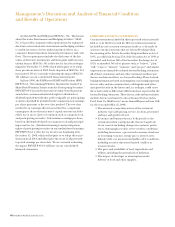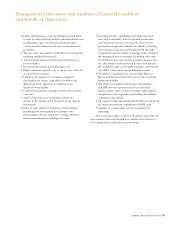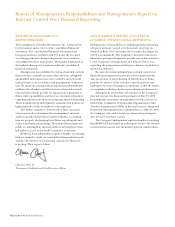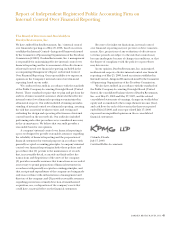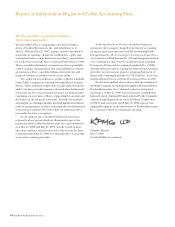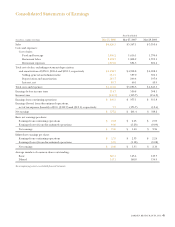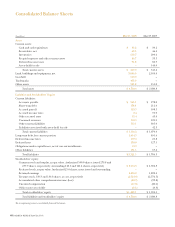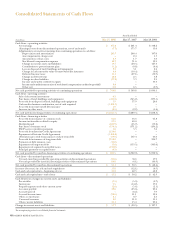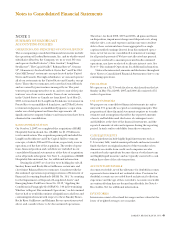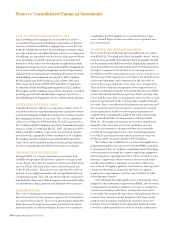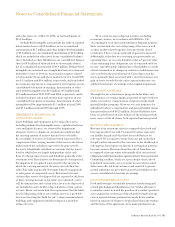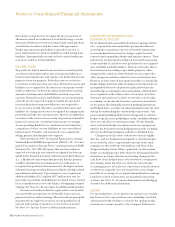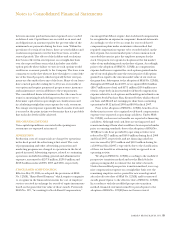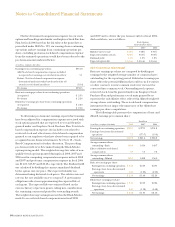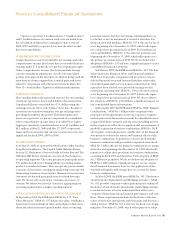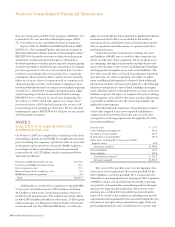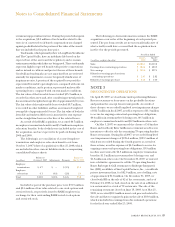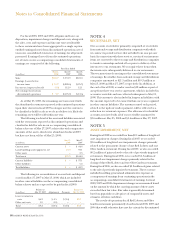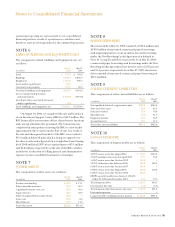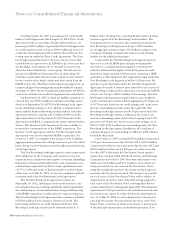Red Lobster 2008 Annual Report Download - page 54
Download and view the complete annual report
Please find page 54 of the 2008 Red Lobster annual report below. You can navigate through the pages in the report by either clicking on the pages listed below, or by using the keyword search tool below to find specific information within the annual report.Notes to Consolidated Financial Statements
50 DARDEN RESTAURANTS, INC.
Notes to Consolidated Financial Statements
LAND, BUILDINGS AND EQUIPMENT, NET
Land, buildings and equipment are recorded at cost less
accumulated depreciation. Building components are depreci-
ated over estimated useful lives ranging from seven to 40 years
using the straight-line method. Leasehold improvements, which
are reflected on our consolidated balance sheets as a component
of buildings, are amortized over the lesser of the expected lease
term, including cancelable option periods, or the estimated
useful lives of the related assets using the straight-line method.
Equipment is depreciated over estimated useful lives ranging from
two to ten years also using the straight-line method. Depreciation
and amortization expense from continuing operations associated
with buildings and equipment amounted to $235.5 million,
$192.8 million and $189.9 million, in fiscal 2008, 2007 and
2006, respectively. In fiscal 2008, 2007 and 2006, we had losses
on disposal of land, buildings and equipment of $2.2 million,
$3.1 million and $2.4 million, respectively, which were included
in selling, general and administrative expenses. See Note 6 –
Land, Buildings and Equipment, Net for additional information.
CAPITALIZED SOFTWARE COSTS
Capitalized software, which is a component of other assets, is
recorded at cost less accumulated amortization. Capitalized software
is amortized using the straight-line method over estimated useful
lives ranging from three to ten years. The cost of capitalized
software as of May 25, 2008 and May 27, 2007, amounted to
$65.3 million and $62.6 million, respectively. Accumulated amorti-
zation as of May 25, 2008 and May 27, 2007, amounted to $37.9
million and $32.2 million, respectively. Amortization expense
associated with capitalized software amounted to $7.6 million,
$7.3 million and $6.6 million, in fiscal 2008, 2007 and 2006,
respectively, and is included in depreciation and amortization
in our accompanying consolidated statements of earnings.
TRUST-OWNED LIFE INSURANCE
In August 2001, we caused a trust that we previously had
established to purchase life insurance policies covering certain
of our officers and other key employees (trust-owned life insur-
ance or TOLI). The trust is the owner and sole beneficiary
of the TOLI policies. The policies were purchased to offset a
portion of our obligations under our non-qualified deferred
compensation plan. The cash surrender value for each policy
is included in other assets while changes in cash surrender values
are included in selling, general and administrative expenses.
LIQUOR LICENSES
The costs of obtaining non-transferable liquor licenses that are
directly issued by local government agencies for nominal fees
are expensed as incurred. The costs of purchasing transferable
liquor licenses through open markets in jurisdictions with a
limited number of authorized liquor licenses are capitalized
as indefinite lived intangible assets and included in other
assets. Annual liquor license renewal fees are expensed over
the renewal term.
GOODWILL AND OTHER INTANGIBLES
We account for goodwill and other intangibles in accordance
with SFAS 142, “Goodwill and Other Intangible Assets,” which
provides that goodwill and indefinite lived intangibles should
not be amortized, but shall be tested for impairment annually or
more frequently if circumstances indicate potential impairment,
through a comparison of fair value to its carrying amount.
Goodwill is tested for impairment as part of a two step process.
The first step of the impairment test requires the identification
of the reporting units, and comparison of the fair value of
each of these reporting units to the respective carrying value.
The fair value of the reporting units is determined based on
valuation techniques using the best information that is available,
such as discounted cash flow projections. If the carrying value
is less than the fair value, no impairment exists and the second
step is not performed. If the carrying value is higher than the
fair value, there is an indication that impairment may exist and
the second step must be performed to compute the amount
of the impairment. In the second step, the impairment is
computed by comparing the implied fair value of reporting
unit goodwill with the carrying amount of that goodwill.
SFAS No. 142 requires goodwill to be tested for impairment
annually at the same time every year, and when an event
occurs or circumstances change such that it is reasonably
possible that an impairment may exist. Annual impairment
tests will be performed in the fourth quarter of each year.
At May 25, 2008, we had goodwill of $519.9 million.
We evaluate the useful lives of our other intangible assets,
primarily intangible assets associated with the RARE acquisition,
to determine if they are definite or indefinite-lived. Reaching
a determination on useful life requires significant judgments
and assumptions regarding the future effects of obsolescence,
demand, competition, other economic factors (such as the
stability of the industry, legislative action that results in an
uncertain or changing regulatory environment, and expected
changes in distribution channels), the level of required
maintenance expenditures, and the expected lives of other
related groups of assets.
Our indefinite-lived intangible assets, primarily the value
assigned to the trademarks acquired from RARE, also are tested
for impairment annually and whenever events or changes in
circumstances indicate that their carrying value may not be
recoverable. We estimate the fair value of the trademarks based
on an income valuation model using the relief from royalty
method, which requires assumptions related to projected
revenues from our annual long-range plan; assumed royalty
rates that could be payable if we did not own the trademarks;


